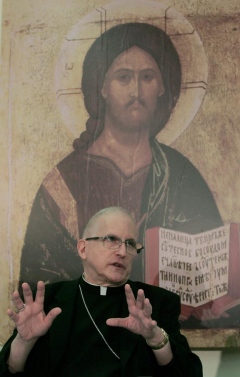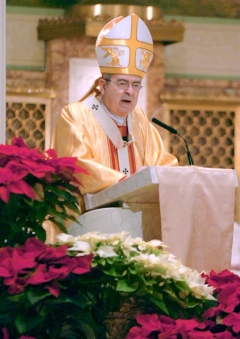By Laura Legere
Citizens Voice
January 3, 2010
http://www.citizensvoice.com/news/search-for-new-bishop-shrouded-in-secrecy-1.522662
Four months after Bishop Joseph F. Martino resigned as head of the Roman Catholic Diocese of Scranton, the search for his successor is well under way. But the exact progress of the search is unclear because the timeline for selecting a bishop is not fixed and the process is largely kept secret.
A spokesman for the diocese declined to specify the status of the process or to say whether the diocese's administrators have submitted a report on the condition and needs of the diocese to the Vatican's ambassador, or apostolic nuncio, in Washington, D.C. - an early step in the process of appointing any diocesan bishop.
 |
| Michael J. Mullen / TIMES-SHAMROCK NEWSPAPERS Bishop Joseph F. Martino resigned as bishop of the Diocese of Scranton last year. In the four months that have followed, there is no clear sign of progress in finding his successor. |
In a written statement, spokesman William Genello said, "The process to select a new bishop typically includes inquiries by the papal nuncio to people in the diocese, regarding conditions in the diocese and potential candidates. This is confidential. It is not known who might have been contacted."
The clearest timeline for the selection process was outlined by Cardinal Justin Rigali, the apostolic administrator of the diocese who also sits on a key Vatican council that helps select bishops, on the day that Bishop Martino's resignation was accepted by the Vatican.
"I would hope - and it is only my hope - I would hope that within six months we would have a bishop," he said during an Aug. 31 press conference. "Maybe sooner, maybe it will take longer."
If the selection process takes six months, which would fall around the end of February, the appointment of Martino's successor will have taken far less time than many appointments of U.S. bishops. The four vacant sees most recently filled in the U.S. waited an average of a year to receive a new leader.
 |
| Jason Farmer / TIMES-SHAMROCK NEWSPAPERS Cardinal Justin Rigali, archbishop of Philadelphia, is one of about 30 cardinals who serve on the Congregations for Bishops at the Vatican, a body that oversees the selection process. |
The process for selecting a bishop begins before a see is vacant. During periodic meetings, the bishops in each province vote on well-regarded priests to add to a list of potential bishops to be sent to the nuncio. Scranton is part of a statewide province whose metropolitan is Rigali, the head of the Archdiocese of Philadelphia.
Once a bishop resigns, is appointed elsewhere, or reaches the retirement age of 75, the nuncio, currently Archbishop Pietro Sambi, requests a report from the leader of the diocese about its condition, needs and challenges. The nuncio also does his own investigation into the needs of the diocese and suitable candidates to lead it. He consults past bishops of the diocese, other bishops in the province and around the country, and the metropolitan. He may also consult priests and lay members of the diocese.
Once he narrows the list to a handful of candidates, the nuncio sends confidential questionnaires to people who know the candidates, including priests, religious and well-respected laity. Those who receive the questionnaire are bound by the code of papal secrecy: they cannot tell anyone that they have received the letters or what they write in response.
The nuncio then gathers the information and writes a report including a list of three candidates, a terna, and notes his preference, which he sends to the Congregation for Bishops at the Vatican, the body of about 30 cardinals, including Rigali, that oversees the selection process.
An English-speaking cardinal assigned to review the Scranton position studies the file and makes a recommendation to the body of cardinals at one of its twice-monthly meetings. The congregation then votes for its preferred choice, which may not be the same as that selected by the nuncio or the presenting cardinal, or it may ask for more information or to be given a new terna.
Once the congregation agrees on its choice, that information is passed on to the pope during a Saturday meeting with the head, or prefect, of the congregation. The pope can follow the council's recommendation or, in a rare case, make a different decision. He is ultimately responsible for selecting the bishop.
E-mail: llegere@timesshamrock.com
Any original material on these pages is copyright © BishopAccountability.org 2004. Reproduce freely with attribution.